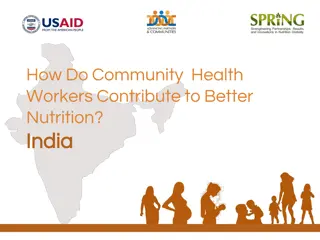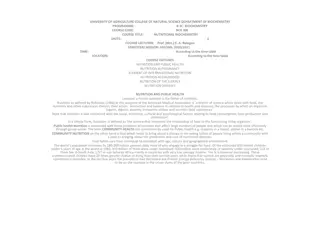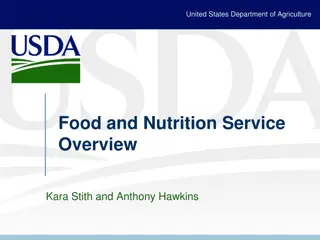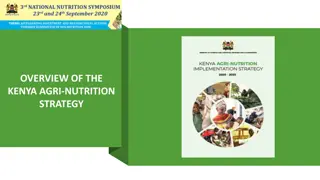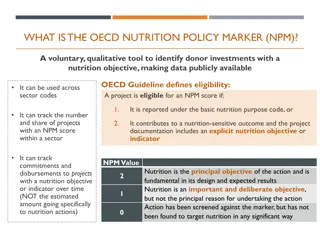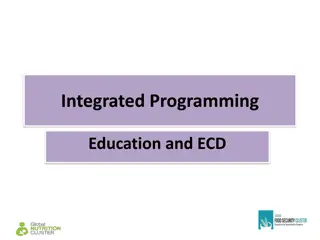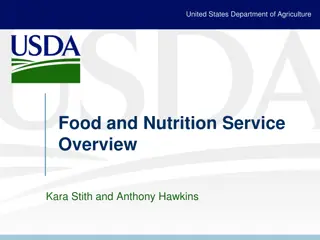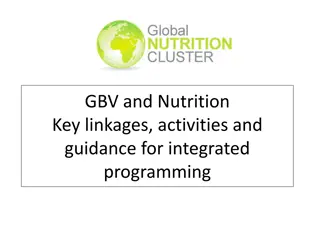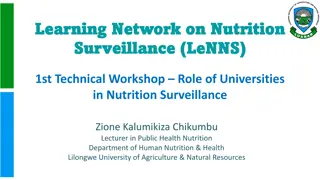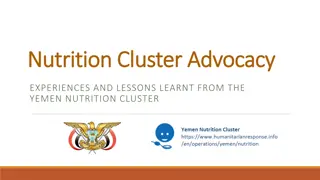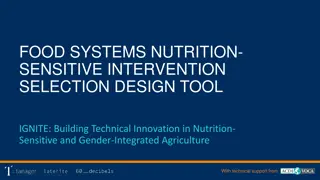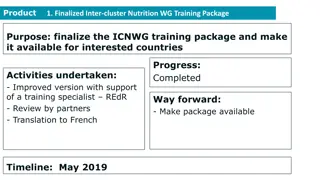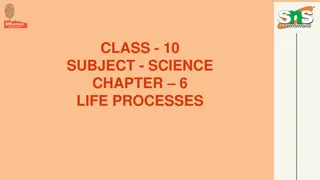Understanding the Importance of Nutrition-Sensitive Agriculture
Explore the critical link between agriculture and nutrition, focusing on the social and economic impacts of malnutrition. Learn why a multi-sectoral approach is necessary, and discover how agriculture can play a significant role in improving nutrition outcomes. Uncover key insights into why the agriculture sector should prioritize nutrition-sensitive practices.
Download Presentation

Please find below an Image/Link to download the presentation.
The content on the website is provided AS IS for your information and personal use only. It may not be sold, licensed, or shared on other websites without obtaining consent from the author. Download presentation by click this link. If you encounter any issues during the download, it is possible that the publisher has removed the file from their server.
E N D
Presentation Transcript
Strengthening Agriculture Strengthening Agriculture- -Nutrition Linkages: Why It Matters Why It Matters Nutrition Linkages: SPRING Nutrition-Sensitive Agriculture Training Resource Package February 2018 The images on this slide were developed by a partnership between the USAID-funded SPRING project, the United Nations Children s Fund (UNICEF), and University Research Co., LLC-Center for Human Services (URC-CHS). All images can be found in the IYCF image bank here: https://iycf.spring-nutrition.org/.
Nutrition Nutrition- -Sensitive Agriculture: The Sensitive Agriculture: The Full Program Full Program One Why Nutrition-Sensitive Agriculture Matters Two Essential Nutrition Concepts Three Essential Concepts in Agriculture & Food Security Four Agriculture-to-Nutrition Pathways Five Developing a Seasonal Calendar Six Social Behavior Change Seven Designing Nutrition-Sensitive Activities
Session Objectives Session Objectives Articulate key information on the social and economic impact of malnutrition Explain why a multi-sectoral approach to address malnutrition is needed Introduce the concept of nutrition-sensitive agriculture Outline specific ways that agriculture can support improved nutrition
Why should the agriculture sector care about Why should the agriculture sector care about nutrition? nutrition? 45% of child deaths are due to undernutrition. There are many short- term and long-term consequences. Photo credit: SPRING/Senegal Source: Source: IFPRI 2016.
5 Cost of Malnutrition Cost of Malnutrition 5 Malnutrition leads to Decreased educational performance Reduced work productivity Reduced earnings Poor nutrition has Poor nutrition has macroeconomic effects macroeconomic effects 11% of GNP lost every year 11% of GNP lost every year Photo credit: J. Hartl, USAID Source: Source: Black et al. 2013; Lim et al. 2012; Horton and Steckel 2013; IFPRI 2016.
Improved Nutrition Improved Nutrition D Drives rives E Economic conomic G Growth rowth Better nutrition Better nutrition Return = $16 Return = $16 Investment = $1 Investment = $1 Economic development Economic development Source: Source: IFPRI 2016; Hoddinott 2016.
What works to reduce undernutrition? What works to reduce undernutrition? Nutrition-Specific Interventions 7 Promotion of correct breastfeeding, vitamin A supplementation, etc. These address the immediate causes of undernutrition, including health status and nutrient intake. Image credit: SPRING Source: Source: Black et al. 2013.
What works to reduce undernutrition? What works to reduce undernutrition? Nutrition-Sensitive Interventions Food security and quality: Availability & accessibility to diverse, safe, nutritious food Health services & Water, Sanitation and Hygiene (WASH): Focus on healthy environments Child & family care: Time, labor, and other resources/practices These address underlying causes of undernutrition Image credit: SPRING
How does agriculture affect nutrition? How does agriculture affect nutrition? Food Produced & Consumed Income Generated & How it is Spent Use of Women s Time & Energy Calories Protein Micronutrients Safety Managing demands on women s time and energy Maximizing women s control of income Diverse diet and nutrient-rich foods Health and WASH services and products
Five Ways to Improve Nutrition Through Five Ways to Improve Nutrition Through Agriculture Agriculture Increase Availability & Access to Diverse, Nutritious Foods 1 1 Encourage Income Use for Better Diets, Health & Hygiene 2 2 Recognize the Central Role of Women in Agriculture and Nutrition 3 4 Generate Demand for Diverse, Nutritious Foods Establish Policies and Programs to Support a Broad View of Nutrition 5
Key Points from This Session Key Points from This Session Good nutrition is essential for children to survive and thrive 45% of child deaths are due to malnutrition. Nutrition is a sound investment, with a $16 return on every $1 spent. Nutrition-sensitive approaches address underlying causes of malnutrition: food security & quality, child/family care, health services & WASH. Agriculture can impact nutrition through food consumed, how income is spent and women s time, energy and control of income. Image credit: SPRING
References Black, Robert E., Cesar G. Victora, Susan P. Walker, Zulfiqar A. Bhutta, Parul Christian, Mercedes de Onis, Majid Ezzati, et al. 2013. Maternal and Child Undernutrition and Overweight in Low-Income and Middle- Income Countries. The Lancet 382 (9890):427 51. https://doi.org/10.1016/S0140-6736(13)60937-X. Hoddinott, J. 2016. The economics of reducing malnutrition in Sub-Saharan Africa, Global Nutrition Report (May 13, 2016). Produced for the Global Panel on Agriculture and Food Systems for Nutrition. http://glopan.org/sites/default/files/Global_Panel_Working_Paper.pdf Horton, Sue, and Richard H. Steckel. 2013. Global Economic Losses Attributable to Malnutrition 1900 2000 and Projections to 2050. In The Economics of Human Challenges, B. Lomborg. Cambridge, U.K.: Cambridge University Press. (IFPRI) International Food Policy Research Institute. 2016. Global Nutrition Report 2016: From Promise to Impact: Ending Malnutrition by 2030. Washington, DC. Lim, Stephen et al. 2012. A comparative risk assessment of burden of disease and injury attributable to 67 risk factors and risk factor clusters in 21 regions, 1990 2010: a systematic analysis for the Global Burden of Disease Study 2010 The Lancet 380(9859): 2224 2260. doi:10.1016/S0140- 6736(12)61766-8.
Thank you! This presentation is made possible by the generous support of the American people through the United States Agency for International Development (USAID) and Feed the Future, the U.S. Government s global hunger and food security initiative, under the terms of the Cooperative Agreement AID-OAA-A-11-00031 (SPRING), managed by JSI Research & Training Institute, Inc. (JSI). The contents are the responsibility of JSI and the authors, and do not necessarily reflect the views of USAID or the U.S. Government.




